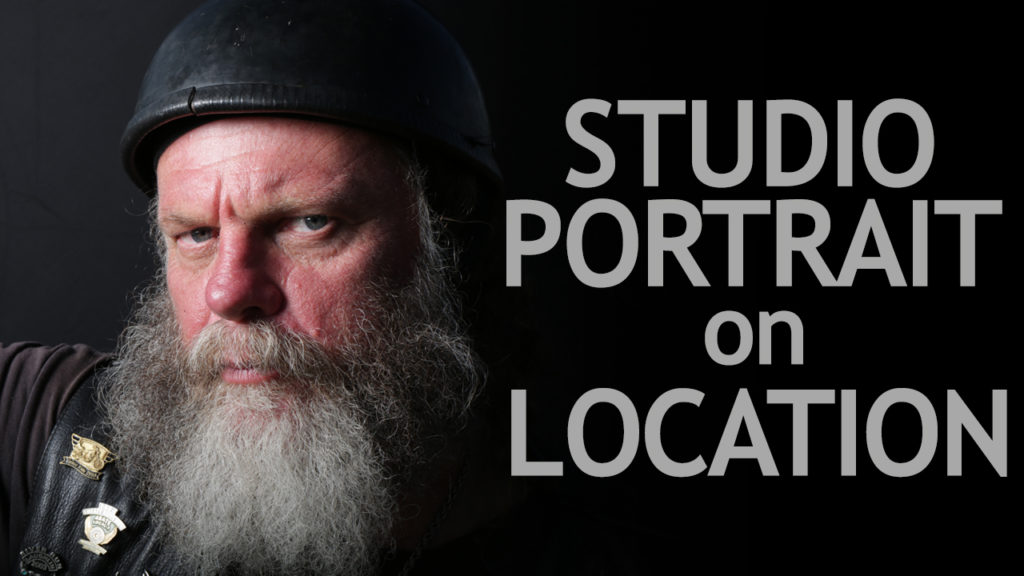Hi, this is Jay P. Morgan. Today on The Slanted Lens I’m going to show you how to make a dramatic studio portrait on location, even though we’re in the midst of bright sunlight. Let’s get started and see what we can do.
We’ve been doing some great environmental portraits here of Keith on his motorcycle. Now we’re going to change it up and show you how to make a dramatic portrait, to get the look of a studio portrait on location, even though we’re in the midst of all this sunlight. I tell my students all the time, “Carry with you a black and a white.” Our 7-in-1 reflectors that Photoflex makes has got a white inside. I love these because I’ve got a built-in black background and white background. They’re great reflectors, but they can be backgrounds if you need them to be.
This is extremely useful when you’re doing any kind of editorial work. If you go in and shoot a portrait of an executive and you want something that looks more studio, you can get a quick white background in there, a great black and white shot. It looks fabulous. This gives you an option to change the look up no matter where you.
Let’s see how we set up the lighting on this. I want to get rid of all ambient light in this situation so I can have complete control and light Keith with my Baja B6 strobe from Dynalite. I’m going to use the exposure triangle, the three things that I can control in my camera.
Number two is the shutter speed. Set your shutter speed as fast as your camera will allow you to go before it starts to clip the strobe. On the Canon it’s going to be 1/200th of a second. That will give you the least amount of ambient light. Then, I’m going to put my strobe on full power and take a strobe meter reading. This will probably be at least two or three stops brighter than the ambient. I’m going to set my aperture on this reading. That should get rid of most of the ambient that we have in this scene.
To test this, I’m going to take a shot without strobes at 100 ISO, 1/200th of a second, at F11. I should have a black, or almost completely black, frame without much ambient in it at all. If there’s just a little bit of light still showing on your subject you can throw up a little bit of a translucent to kill the light a little more. You now have a clean canvas you can start to light in. If you have a little bit of background showing through, then just simply put your black background behind him. That’ll clean anything else up that’s left back there.
At this point you can turn your strobes on, take your exposure and shoot away. I’ve got my box in there. I’ve tilted it up a little bit. I like to work my light around behind and away from him a little bit. That gives a nicer light on his face. I like the fall off- it feels like a gorgeous, dramatic portrait. A one light portrait you’d do in the studio. By simply controlling the ambient light, you can get right to it and shoot some beautiful images.
I’m using a Tamron 85mm lens for this shot. I like that range, 85 to 100, maybe a little over 100 depending on the person and their face. That’s the range I want to be in with my lens. The 85 is a beautiful lens for doing these kinds of portraits. Let’s take a look at some of the portraits we shot of Keith.
Being able to get this kind of dramatic look on location is a really useful thing. If you’re doing an editorial piece, for an executive, if you’re out with a bride, you can change the look up almost immediately. Just jump in there, get a different shot, something the bride’s going to say, “Wow, I’ve never seen anything like that.” It’s fast and simple to do. Bring something black, something white, a reflector you can pop in there to be able to give yourself a different look almost immediately. When people say to me, “I can’t shoot, I don’t have a studio,” I think, “We just shot a studio shot out here on location, a dramatic one light studio portrait on location.”
Go to our community group and share some of the portraits you’ve done using this technique.
Keep those cameras rollin’. Keep on clickin’.
-Jay P.

